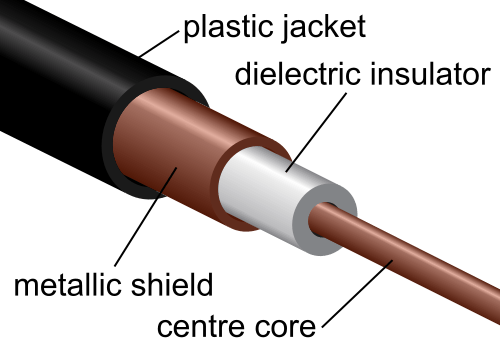Coaxial Cables and Triaxial Cables Information
Coaxial cables have an inner conductor insulated by a dielectric material and then surrounded by an outer conductor that is shielded with braid or foil. Triaxial cables add an extra layer of insulation and a second conductive sheath. Coaxial cables, or “coax” as they are commonly called, can be run next to metal objects without experiencing the power losses that are common to other types of transmission lines. Coax also protects signals against external electromagnetic interference. Triaxial cables or “triax” provide greater bandwidth and interference rejection, but are more expensive than coax.
The IEEE GlobalSpec SpecSearch database categorizes cables in this product as either coaxial or triaxial. When selecting products, industrial buyers should specify details about the cable's insulation material, conductors, impedance and shielding.
Specifications
Conductors
A cable conductor consists of a wire or combination of wires that are not insulated from each other, and facilitate the passage of electric current through the cable. Conductor-related specifications include material and size.
Conductor material includes various conductive metals. Copper is the most widely used material, and features excellent corrosion resistance and high thermal conductivity, but relatively low strength-to-weight ratio. Aluminum is less dense than copper, and is often used as a power conductor. Cable conductors may also be made of steel and clad with an aluminum or copper shell.
Conductor size is measured in American Wire Gauge (AWG) in the United States. The higher the gauge number, the smaller the diameter and thinner the wire. Thicker wires have less resistance and are able to carry more current. Outside of the U.S., conductors are measured in mm2.
Jacket and Insulation Material
Suppliers manufacture cable using a variety of jacket and insulation material in order to reduce the leakage of current from the conductor. The cable's application is an important consideration when selecting insulation material.
Neoprene is a synthetic rubber well-suited to chemical applications. It is resistant to oil, flames, and chemicals.
Silicon rubber provides superior flexibility but lacks toughness and fluid resistance.
Thermoplastic is an excellent insulating material. Polyethylene (PE), polypropylene, polyvinyl chloride (PVC), Teflon®, and Tefzel® are types of thermoplastic material. While each material has its own unique advantages and disadvantages, most are highly flexible and provide resistance to moisture or chemicals.
Impedance
Characteristic impedance is an important specification when selecting coaxial cable and other transmission lines. It is defined as the ratio of the voltage applied to the current of a uniform line of infinite length. In this case, the cable represents the uniform line. The three main coaxial cable impedance groups are 50, 70 and 93 ohms.
This software demonstration explores detailed information about characteristic impedance.
Video credit: Explore RF / CC BY-SA 4.0
Shielding
Coaxial and triaxial cables may feature a type of electromagnetic shielding material, which is wrapped around the cable underneath the outer jacket. Shielding serves to prevent electrical noise from affecting the transmitted signal, and to reduce electromagnetic radiation emission from the cable itself. Shielding is typically comprised of metal braiding, metal tape or foil braiding. A shielded cable may also feature a special grounding wire known as a drain wire.

Cutaway image of a shielded cable. Image credit: Tkgd2007
References
Coaxial Cable vs. Triaxial Cable
- Arkansas
- Arizona
- California
- Colorado
- Connecticut
- Florida
- Georgia
- Iowa
- Idaho
- Illinois
- Indiana
- Louisiana
- Massachusetts
- Maryland
- Maine
- Michigan
- Minnesota
- Missouri
- Mississippi
- North Carolina
- Nebraska
- New Hampshire
- New Jersey
- New Mexico
- New York
- Ohio
- Oklahoma
- Oregon
- Pennsylvania
- Rhode Island
- South Carolina
- Tennessee
- Texas
- Virginia
- Vermont
- Washington
- Wisconsin
- AWG 2/0, 3/0, 4/0 or Larger
- Aluminum Clad Steel
- Aluminum and Aluminum Alloys
- Braid
- Bulk Cable
- CE Marking
- CSA Mark
- Cable Assembly
- Copper Clad Steel
- Copper and Copper Alloys
- Drain Wire / Copper Wire
- Foil / Copper Tape
- Foil Braid
- IEC
- ISO
- MIL-SPEC
- Neoprene
- No Shielding
- Polyethylene (PE)
- Polyvinyl Chloride (PVC)
- RoHS
- Silicon Rubber
- Teflon®
- Tefzel®
- UL Recognized Component Mark (US and Canadian)
- mini cable reel electric
- triaxial cable
- RG58 coaxial cable
- satellite coaxial cable
- low loss coaxial cables
- 50 ohm triaxial cable
- 777 MCM cable
- coaxial cable specification
- 100 ohm twinaxial cable
- 14 AWG Coaxial Cable
- 36 AWG coaxial cable
- 75 ohm twinax cable
- armor coaxial cable
- cable reel standard size
- coaxial cable 40awg
- coaxial cable high temperature
- coaxial cable splice
- custom coax cables
- high voltage coaxial cables
- LAN materials and equipment
- low noise coax cable
- low noise coaxial cable
- multi coaxial cable
- quad shield coaxial cable
- radiating cable WiFi
- rg316 spec
- thin coaxial cables
- 1855A
- 75 ohm triaxial cable
- coaxial shield HFSS
